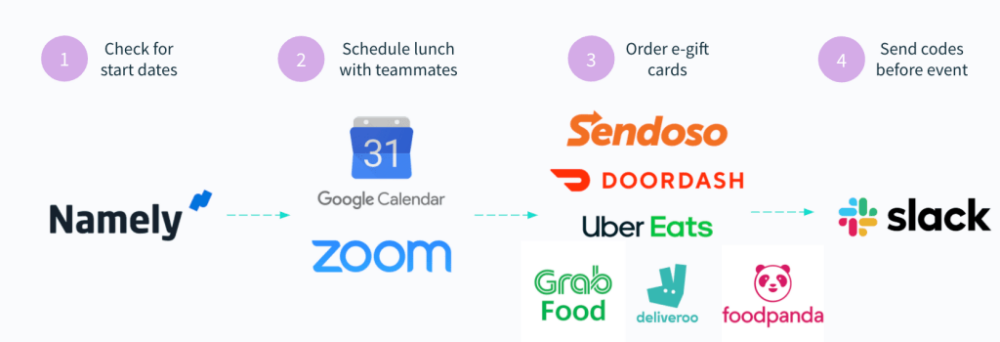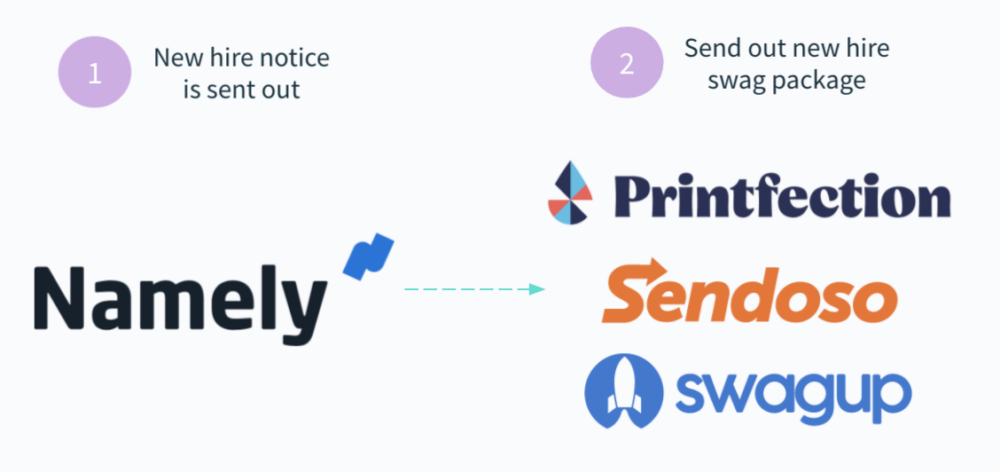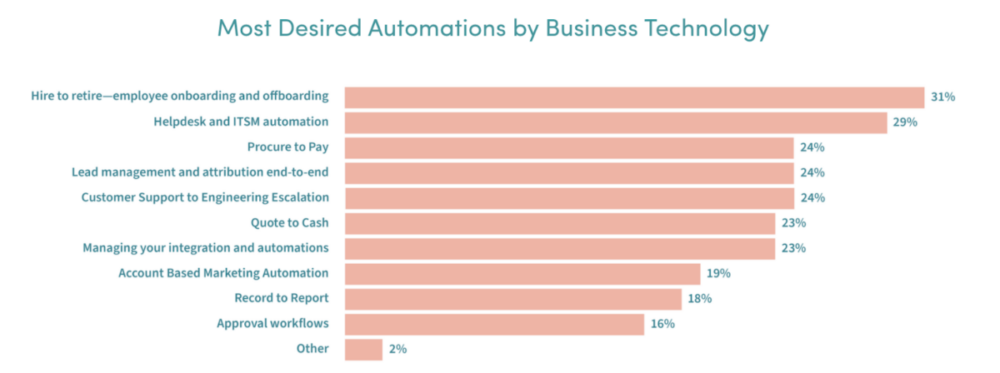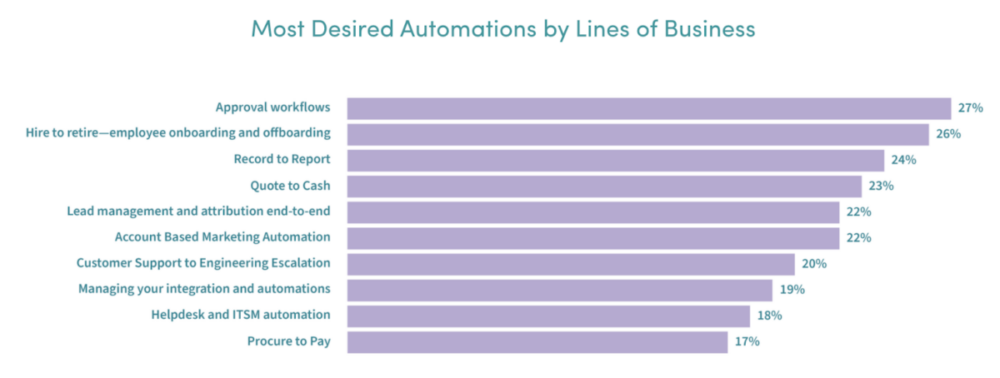According to Gallup, just 12% of employees believe that their organization does a great job of onboarding its new hires.
This stat shouldn’t be taken lightly for employers, as poor onboarding experiences can negatively impact employee retention, productivity, and the employer’s reputation.
You can prevent bad onboarding experiences by engaging in onboarding automation.
What parts of onboarding can you automate? What are the benefits of performing this type of HR automation? And how can you go about implementing it at your organization?
We’ll walk through the answers to each of these questions. That way, you’ll have all of the wisdom and practical tips you need to automate your onboarding processes. But to start, let’s review the drawbacks of a traditional, manual approach to employee onboarding.

Automate your onboarding process end-to-end with Workato
Learn how Workato, the leader in enterprise automation, can help your team automate employee onboarding in a matter of minutes and without having to write a single line of code.
The challenges of onboarding employees manually
The following factors by and large explain why most employees don’t think that their employer does a good job of onboarding them:
- The employee onboarding process feels impersonal
Your employees need to start engaging with colleagues as soon as possible in order to be productive. However, when your HR team is performing individual tasks manually, this want becomes a near impossibility to satisfy. It involves introducing new hires to their colleagues, scheduling one-on-one lunches, organizing offsites, etc.—all of which asks for too much from an HR department that’s already strapped for time.
- The employee experience falters
As your employees start their new jobs, they’ll need answers to a wide array of questions.
Without an easy, automated means of providing them, they’re either left in the dark or investing too much time searching for answers. Equally bad, they might ask colleagues (especially those in IT) the same set of questions over and over again. This can quickly take up the latter’s time and prevent them from performing more business-critical tasks.
- Administrative tasks are performed slowly and leave your team vulnerable to making significant mistakes
Manually provisioning employees access to facilities, apps, and procuring equipment can be time-intensive and hard to do accurately at scale. As a result, many of these tasks may be delayed, and even once they’re complete, there’s a chance they’re executed poorly.
In either case, the results can be disastrous. For example, new hires may inadvertently gain access to confidential employee data, putting your company in potential legal trouble. And the process of completing each new hire’s I-9 document may extend past 3 days from their start date, leading your organization to face costly penalties.
With this context in mind, we’re ready to dive into onboarding automation, starting with its definition.
What is onboarding automation?
It’s the use of automation to streamline onboarding-related workflows. Its implementation involves a platform that can listen for a predefined business event, where once it occurs, the platform triggers actions that can work across your apps, data, and teams.
Onboarding automation can tackle the gamut of tasks required to prepare for a new employee as well as get them up and running. This can be any of the following (and a whole lot more):
- Providing them with the applications and equipment they need
- Scheduling a variety of orientation meetings
- Organizing and distributing all the onboarding documents that need to be reviewed and signed
- Pairing them with a mentor or buddy
- Sending them a package with company swag
- Delivering a survey to gather feedback on the onboarding process
With this context in mind, let’s review how automating your HR onboarding processes can work.
5 ways to automate employee onboarding
Here are just a few common applications:
1. Streamline pre-boarding workflows
Once an employee is marked as hired in your applicant tracking system (e.g. Greenhouse), you can use an integration-led automation platform to trigger off the following actions before their first day:
- Their profile in your HRIS (e.g. Workday) gets created.
- Their Okta user account gets set up.
- A welcome email gets sent to them.
- Their account in an IT service management system (e.g. ServiceNow) gets created, and a ticket gets added to track the new employee’s progress throughout the onboarding stages.
Popular Namely integrations
2. Instantly provision apps
This onboarding automation requires a platform bot that can communicate between your business communications platform (e.g. Slack) and the rest of your apps.
Here’s how it works here at Workato.
1. Once a new hire notice—an email that alerts key stakeholders of details on the new hire— gets sent from an HRIS, the workflow gets triggered.
2. An HR chatbot messages the new hire’s manager via your business communications platform, asking them to select the apps they should receive access to.
3. Once the manager makes their selections, the BT team receives a message in a channel within the business comms platform—alerting them of the requested apps.
4. Anyone who belongs to that channel can review the request, check if there’s licenses available across the relevant apps, and then approve (or reject) the request.
5. Once approved, the bot notifies the hiring manager via a message in your business comms platform.
Note: As mentioned at the end of the video, new hires can gain access to additional apps, lose access to any, or have their level of access change for a given app at any point (we manage these requests through another chatbot called “Firefighter Bot”).
3. Give new hires a place to connect and get their questions answered
The following automation ensures that new employees attend an orientation meeting on their first day and have a way to introduce themselves and connect with colleagues who start at the same time.

1. Once your HRIS identifies employees who’ll start at the same, the workflow gets triggered.
2. Your orientation meeting gets scheduled and the new hires get invited to it.
3. The new hires get added to a channel in your business communications platform.
4. Invite new hires to lunch with their team members
This automation accounts for employees who work remotely, but it can just as easily work for employees who work in the same office.

1. Once your HRIS identifies employees who’ve recently joined, the workflow gets triggered.
2. A meeting gets scheduled between a new hire and one of their team members, where the invite includes details for joining the meeting (via a platform like Zoom).
3. Both the new employee and their team member receive a gift card from a food delivery app (via a message in your business comms platform) during the morning of the day they’re getting lunch.
5. Send new hires swag before they start
The following relatively simple automation ensures that every new hire receives company-branded swag a week or so before their official start date.

1. Once the new hire notice is sent out via your HRIS, the workflow gets triggered.
2. The employee receives a pre-selected box of swag from a tool like Printfection the week before their start date.
Related: 18 HR automations statistics that help explain where the candidate and employee experience is headed
Benefits of an automated onboarding process
Now that you know some of the ways you can implement onboarding automation, you likely have a sense of the benefits they bring to your new employees and to the organization. In case any slips your mind, here’s a complete breakdown:
- They allow your organization to avoid security risks. Human errors can lead to all kinds of security issues, such as giving employees access to documents that contain a colleague’s personal information. Onboarding automation significantly reduces the chances of these types of errors from occurring as many error-prone tasks can be streamlined.
- They provide time savings for both hiring managers and employees in HR. Now that hiring managers and employees in human resources can avoid tedious, manual tasks, like hopping between apps to provision new hires with the appropriate apps and equipment, they can focus more, instead, on thoughtful and meaningful work.
- They let employees be productive from the onset as they’re given the apps and equipment they need to execute on day 1.
- They drastically improve employee retention. According to the Human Capital Institute, 69% of employees are more likely to stay with their employer for at least 3 years if they have a positive onboarding experience.
- They delight your new hires. Since new hires have everything they need to be successful from the get-go, they’re more likely to feel welcomed and empowered in their role. BambooHR verified this: Employees who found their onboarding to be effective were 30x more likely to report high job satisfaction.
- They give your organization a competitive edge. The Human Capital Institute also found that more than half (58%) of organizations’ onboarding experiences focus on paperwork and processes. If your onboarding process can strip away these unpleasant tasks, or at least make them easier to get through, your organization should be set to stand out.
- They inspire new hires to become advocates of your organization. 1 in 5 employees wouldn’t recommend their organization to family or friends following their onboarding. Onboarding automation not only prevents new hires from becoming detractors, but it also increases the chances that they actively promote your organization to others.
- They provide a means for new hires to socialize. The ability to have casual conversations with colleagues can actually lead to positive business outcomes, such as increasing employee productivity and satisfaction.
- They help your new hires get excited about their job. Distributing company swag gives new hires just another reason to look forward to working at the company, and it gives them a positive first impression of your company culture.
Given all these benefits, there’s little wonder that both Business Technology (BT) and lines of business put onboarding automation at the top of their list of desired automations.
Here’s what we found when we surveyed 100+ BT leaders:

And here’s what we found after surveying 300+ employees across lines of business.

Wondering what else each group said about building and using different types of automations? You can find out by downloading our State of Business Technology Report.
How to automate any onboarding process
There are generally 3 steps you should follow:
1. Identify the specific processes that are currently performed manually.
If you haven’t implemented employee onboarding automation in the past, you’ll likely find a variety of manual processes that can be streamlined. This can be anything from scheduling the same set of meetings for each new hire to coordinating between the hiring manager and IT for provisioning the new hire with the right apps and equipment.
2. Prioritize the processes you want to automate.
For all the manual tasks you identified in step 1, try to pinpoint those that are more important to automate based on their potential impact on the new hire, the rest of your team, and the organization more broadly.
The criteria you factor in for every potential automation includes projected time savings, the types of errors that are likely to be prevented, the number of employees who are likely to profit, the extent to which new hires benefit, etc.
3. Work with BT to build the automation.
You’ll not only want to tell your colleagues in BT which processes you want to automate, but also walk them through how you’d like to see the process operate once automated. This includes walking them through the business event that triggers the workflow, and, once triggered, how the data should move between the systems.
Your colleagues in BT might have better ideas on how to implement a certain onboarding automation, but coming to them with a clear approach is a great starting point.

Ready to streamline your onboarding workflows?
Learn how Workato, the leader in enterprise automation, can help by scheduling a demo with our team.
